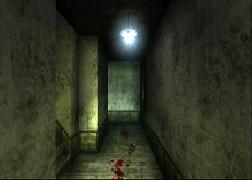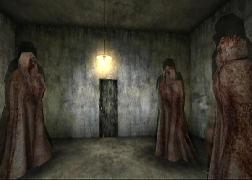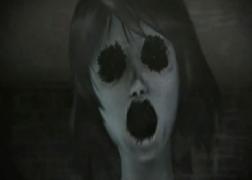Also known as: Night of Sacrifice
Platforms: Wii
Release Date: 2011-03-24
Regions: Japan
Chris’s Rating: ★★★☆
Incredibly simple gameplay is made scary by the use of the Wii Balance Board for movement.
Ikenie No Yoru (???????, “Night of Sacrifice”) is the only game I know of that uses the Wii Balance Board other than Nintendo’s own Wii Fit. It’s a horror game set in rural Japan, a desolate spot called Tsukuyomi Ravine, and stars five high school students identified by colors. Blue is the protagonist, Yellow is the heroine, Pink is the popular girl and Red is her boyfriend. They are visiting a home owned by Black’s father, who vanished without a trace some years ago. You can leave the characters with color-based names if you want, but the game encourages you to name them after your real life friends.
The game mechanics are extremely simple. Walking in place on the Balance Board causes the first-person viewpoint to walk forward in the game. You set the pace with your feet, and often you will find it necessary to literally run for your life. The Wiimote acts as a flashlight and allows you to steer your character through the house, the surrounding buildings, and of course, various basements and caves and other foreboding places. These areas are inhabited by ghosts who will kill you in a single hit if you get too close (the game helpfully records the exact time and date you were ‘cursed’), but they can generally be avoided by high-tailing it or occasionally sneaking around. There are doors to open and a few notes to find lying around, but there is no inventory, no items to collect, no health and no life bar and no weapons. The levels are pretty much linear–all you can do is traverse from point A to point B, avoiding ghosts along the way. This is first person exploration in one of its simplest forms.
From a design perspective, Ikenie No Yoru is barely even a game. There have been simple, non-combat first person horror games before (think Hell Night and Echo Night: Beyond), but those games involve more traditional item puzzles, or at least labyrinthine level design. Ikenie No Yoru does feature a few different forms of challenge (sneaking, running away, hiding, searching, balancing on the Board), but all of them are based on the two extremely basic inputs: moving forward by walking and navigating with the Wiimote. Heck, the only button used in the game is A, and only then to open doors. The enemies are generally brainless, and though they will sometimes chase you, they mostly just stand around. The only puzzles in the game involve figuring out how to navigate through gauntlets of enemies without getting grabbed and cursed, and generally these are very easy. In fact, the game designers have gone out of their way to make sure the game is easy: some levels even have signs that say things like, “anybody being chased by a ghost should hide out here.”
Sounds pretty unsophisticated, right? The graphics are passible, but this is a Wii game and they are nothing special. The art style makes some interesting choices related to character design, but mostly you are walking around through very dark, oppressive places. Basements and caves and tunnels and things like that; if you have ever played a horror game before it is all familiar territory. The enemies are the same sort of pale-person-with-no-eyes type that plague a lot of other recent Japanese games, and there are only three or four variations total. The music and sound are quite nice, and in some places done particularly well, but for the most part the sound is understated and subtle. There’s a story, and it’s presented in an interesting way, but it has no real bearing on the game play.
Ikenie No Yoru is a horror game with literally nothing extra. It’s only real stand-out trait is that it uses the Wii Balance Board for movement. It is about as basic as you can make it.
And yet, the crazy thing is, it totally works.
Ikenie No Yoru is way scarier than it has any right to be. There’s nothing about the game itself that is particularly convincing, and as a grizzled horror game veteran I pride myself in waltzing through these games as an analyst rather than a participant, but Ikenie No Yoru got the drop on me more times than I’d like to admit. The game play is trivial, the graphics are inconsequential, and the story is mostly revealed outside of the game itself. But despite its absolutely basic interface and ho-hum content, Ikenie No Yoru is a scary game.
The key to Ikenie No Yoru’s success is the Wii Balance Board. The first-person interface, combined with actually stepping on the Board to make your character take a step in the game, makes the content totally work. Similar games with similar interfaces (like Calling and Ju-on: The Grudge) are not as effective because they do not use the Board. Even so, it wasn’t clear to me what it was about the Balance Board that made it effective. Why does Ikenie No Yoru’s content work when similar games come off as simplistic and arduous?
First, the level design and game content, while simple, is well-made. There are no mundane problems with collision detection or controls, and the levels remain diverse and compelling even though they are incredibly linear. The character animation is pretty good and the story is interesting. Though there’s not much to it, what’s there is good. Most importantly, there’s nothing to pull you out of the experience.
Before playing Ikenie No Yoru I wondered if the Two-Factor Theory of Emotion would make a game designed to raise your heart rate with exercise extra scary. Now that I’ve completed the game it seems like a solid explanation. The required physical motion is pretty light, but it did cause my heart rate to go up. I walked a total of about 15000 steps for this game, and toward the end I could feel each running escape in my calves. There is definitely enough work going on to increase my physiological state, but not so much that I was aware of it while playing. After each session, however, I noticed that I had started to sweat, and my legs had that pleasant burning associated with a good walk. During play my focus was squarely on the game. The two factors of the theory are elevation of physical state without an obvious cause and a contextual cue from the outside environment that the mind uses to make up a label for the elevated state. Ikenie No Yoru seems to meet those requirements perfectly: walking on the Balance Board is enough to cause your heart rate to rise and your breathing to increase, but not so much that you are conscious of it. At the same time, the game is streaming its horror content in first person, sans any sort of HUD or other on-screen display, directly into your brain through your eyes and ears. If we believe that Two-Factor works, the theory tells us that our brain may react to these inputs by mistaking our elevated physical state for fear and synthesizing an emotional response. The result, at least for me, was a fun and sometimes genuinely stressful experience.
As an aside, Ikenie No Yoru also has a funny bonus mode that you can unlock after beating the game on Hard Mode. The funny mode, called Heart Mode, uses the game content and characters to create a short faux-erotic game (“eroge,” as the Japanese say). It’s just a joke: there’s no actual nudity or erotic content of any sort, just the characters saying the same vapid things that eroge characters say (“I’m going to need to to check my entire body for signs of the curse!”), and I’m sure the developer didn’t intend for anybody to actually take it seriously. Still, I have to wonder: there is evidence that the brain hack described by the Two-Factor Theory can be used to falsify arousal the same way it can falsify fear. Is Heart Mode more effective as erotic content than it was intended to be because it requires the player to walk in place a bit as he plays? I didn’t actually unlock the mode, but it’s an interesting thought.
Though the content of Ikenie No Yoru is pretty thin, there are some areas where the developers betray their hardcore influences. The game is broken up into missions, short episodes that are organized around several playable characters. There’s also a section of missions called “Afterward” that take place after the main events of the game and star anonymous characters. The missions unlock such that you play a few missions with a character, then go play some Afterward missions, then go back and play more with another character. It’s not as complex or interesting as the crazy characters-over-time spreadsheet in Siren, but it serves a similar purpose: it delivers bits of story, out of order, across multiple characters, such that that the significance of certain events is not clear until the game is complete. There’s some Silent Hill film grain going on, and the characters look like something out of Kamaitachi No Yoru, solid-color silhouettes (presumably to make it easy to mentally replace them with the real life friends after which they are named). In addition to the simple narrative the game is occasionally interrupted by cell phone messages (from unknown senders, of the “diediediediedie” variety), which is a nice touch as well. Though Ikenie no Yoru is clearly designed to be a casual game, its developers are clearly familiar with the hardcore stuff.
Ikenie No Yoru is a very short, very easy game. It has few flaws, mostly because there’s not enough there to actually be flawed. Despite its casual approach and extreme simplicity, it works very well as a horror game because it uses the Wii Balance Board as a primary input. It is a fascinating example of the Two-Factor Theory of Emotion in action, and, occasionally, surprisingly scary. It’s worth a look as an outlier in this genre that works.





